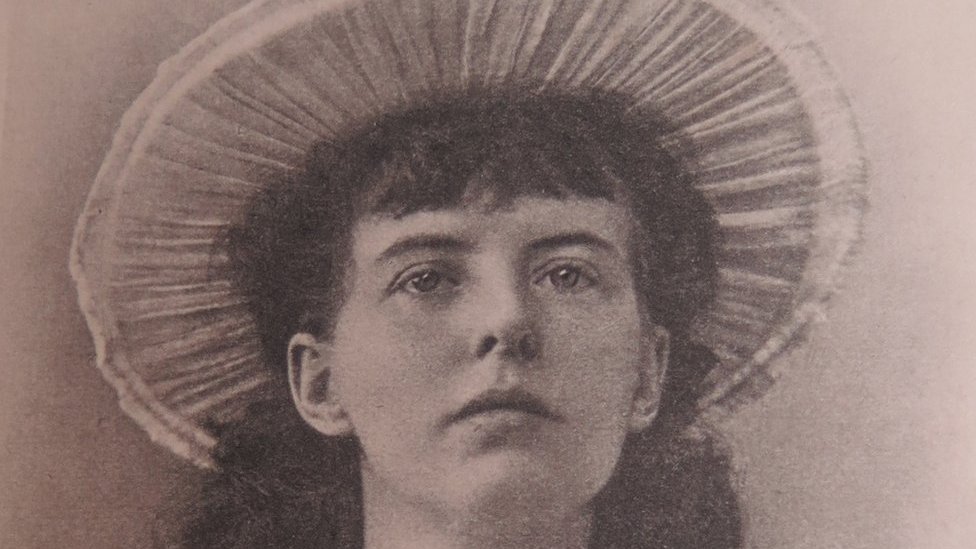INSUBCONTINENT EXCLUSIVE:
Image caption
Violet Nicholson was a best-selling poet in the late 19th Century
For a best-selling
author, Violet Nicolson's grave gets vanishingly few visitors
It lies in a hard-to-find corner of one of India's most unkempt colonial-era cemeteries - a forlorn and abandoned place where obelisks,
crosses and funeral statuary peep out from the dense undergrowth
This is the Island - an overspill burial ground - in the southern Indian city of Chennai (formerly Madras)
It's located a couple of miles from its 17th-Century mother church, St Mary's, the oldest Anglican church not only in Chennai but anywhere
east of Suez.There is a poetic aspect to Nicholson's overgrown burial spot
Her poems - once hugely popular - are now almost as forgotten as her resting place
She belongs to another era - that last generation of the British in India whose confidence in Empire was unsullied, before war and the rise
of nationalism heralded a slow, reluctant retreat
Nicholson, whose formal name was Adela Florence Nicolson, shares the grave with her husband, Malcolm Nicolson, a retired general in the
They died in Madras within weeks of each other in 1904
They were both gifted linguists with a deep affinity for India, and Nicholson offered in her writing a startlingly unorthodox view of
Britain's prize imperial possession.She wrote of love, longing, suffering and death, and above all of India - of Punjab and the North West
Image caption
Nicholson and her husband are buried in a graveyard in Chennai
She at first made out that
her poems were translations of Sufi-style poetry - and she published under a man's name, Laurence Hope
But they were all her own work
Her books sold impressively and, while she was never fashionable among the literary elite, the novelist Thomas Hardy was among those who
expressed appreciation of her writing
Some verses of hers, set to music, became massively popular - and kept her name and work alive into the 1930s
One of these began: 'Pale hands I loved, Beside the Shalimar'
I remember my father singing those lines to no one in particular when I was a young boy
It includes a striking couplet addressed to those 'pale hands': I would rather have felt you round my throatCrushing out life; than waving
me farewell!The poem is called "Kashmiri song" - "pale" is a reference to the fact that Kashmiris are often described as fair-skinned
There is an ambiguity, perhaps deliberate, about the gender and racial identity of narrator and lover
Some of her poems are deeply transgressive: addressing not just gender and race, but betrayal, harm and the erotic, in ways which we rarely
associate with that apparently strait-laced Edwardian era
Whether this was fantasy, exotic fable, or based in part on experience, we just don't know.The story of Nicolson's death is both tragic and
Her husband was much older
He needed a prostate operation, but it went wrong and the hospital had run out of oxygen
A few weeks later, his 39-year-old widow - with a four year-old son in the care of relatives in England - took her own life
Image caption
This was one of Nicholson's most popular poems
Gossip travels fast, and the word went out
that this poet, so knowledgeable about Indian customs and lore, had committed sati - an ancient, and long-outlawed, Hindu custom of a wife
taking her own life when her husband dies
Nicholson's poems gained in popularity after her death, and were published in many editions - from cheap, slim collections to deluxe,
embossed volumes with elaborate illustrations
The sombre, reflective tone of her writing seems to have struck a chord in 1920s Britain as the country sought to come to terms with the
trauma of World War One.Her sister, Annie Sophie Cory, was also a writer - using the pen name Victoria Cross, she wrote racy novels
Her most popular, Anna Lombard - published in 1901 - is said to have sold six million copies
Set in India, it's about a genteel young English woman who takes her Indian servant as her lover and won't give him up even when she gets
engaged to an eligible English colonial administrator
Her lover dies, but she discovers she is expecting his child
She marries her English fiancé and they move away; when the baby is born, she realises that her husband can never abide this living
reminder of her Indian lover
So… she suffocates the child
Image caption
Nicholson was just 39 years old when she took her own life
It's fiction, of course
But this sensational storyline does make you pause
The novel violates so much of what is expected of a refined English woman in India at the time
You wonder whose anxieties are being expressed in this tangled plot - and what its emphatic commercial success says about its readership:
that they liked to be shocked and appalled or, in some vicarious manner, wanted to share in the thrill, and agony, of a woman who breaks the
The writings of both sisters challenge some of the conventional assumptions about Empire - about the attitudes and experiences of those
Britons who made their lives in India
Colonial graveyards such as St Mary's are often among the most potent epitaphs of an enterprise which by-and-large history does not judge
But delve deeper beneath that dense mat of vegetation, and it's extraordinary what you can find

